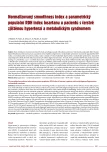Adrenal incidentalomas – is the present management rational?
Authors:
I. Lazúrová
Authors‘ workplace:
I. interná klinika Lekárske fakulty UPJŠ a FN L. Pasteura Košice, Slovenská republika, prednostka prof. MU Dr. Ivica Lazúrová, CSc.
Published in:
Vnitř Lék 2010; 56(9): 961-966
Category:
60th Birthday - Andrej Dukat MD, Csc., FESC
Overview
Adrenal incidentalomas, i.e. clinically inapparent adrenal mass, are considered to be one of the most frequent tumours in human pathology. They more frequently occur in women, older age, patients with metabolic syndrome and in patients with malignant diseases. The first step in the management is exclusion of hormonal activity and differentiation of malignant and benign lesions. At present, there is no consensus with respect to differential diagnosis and treatment of adrenal incidentalomas since the development of hormonal hyperfunction and a risk of malignancy are negligible. The most frequent cause of hyperfunction is subclinical hypercortisolism, the clinical significance of which is also questionable. Recently, it has been shown that the existing recommendations lack rationality and, in addition, increase risk of falsely positive hormonal investigations. Repeated CT scans subject the patients to ionising radiation and may carry the same or even higher risk of cancer than the risk of malignant transformation of adrenal incidentaloma. This is why it is important to develop recommendations for screening and subsequent ‘follow‑up’ that will be rational, safe for the patient and reliable.
Key words:
adrenal incidentalomas – management – primary hyperaldosteronism – pheochromocytoma – subclinical hypercortisolism
Sources
1. Kršek M. Adrenal incidentalomas. Vnitř Lék 2007; 53: 821– 825.
2. Cawood TJ, Hunt PJ, O’Shea D et al. Recommended evaluation of adrenal incidentalomas is costly, has high false positive rates and confers a risk of fatal cancer that is similar to the risk of the adrenal lesion becoming malignant: time for a rethink? Eur J Endocrinol 2009; 161: 513– 527.
3. Gross MD, Korobkin M, Hussain HK et al. Adrenal Gland Imaging. In: De Groot L (ed). Endocrinology. Philadelphia: W.B. Saunders Comp 2006: 126.
4. Mansmann G, Lau J, Balk E et al. The clinically inapparent adrenal mass: update in diagnosis and management. Endocr Rev 2004; 25: 309– 340.
5. Kršek M. Adrenal carcinoma. Vnitř Lék 2009; 55: 54– 61.
6. Lazúrová I, Sokol L, Trejbal D et al. Aldosterone producing adenoma associated with foci of myelolipoma. Wiener Klin Wochenschr 1998; 110: 379– 381.
7. Lazúrová I, Závacky P, Ondic O. Adrenal actinomycosis mimicking a large tumor of the adrenal gland. J Urol 2005; 173: 517– 518.
8. Zeiger MA, Thompson GB, Duh QY et al. The American Association of Clinical Endocrinologists and American Association of Endocrine Surgeons medical guidelines for the management of adrenal incidentalomas. Endocr Pract 2009; 15 (Suppl 1): 1– 20.
9. Beuschlein F. Adrenal incidentalomas: presentation and clinical work‑ up. Horm Res 2007; 68 (Suppl 5): 191– 194.
10. Morelli V, Masserini B, Salcuni AS et al. Subclinical hypercortisolism: correlation between biochemical diagnostic criteria and clinical aspects. Clin Endocrinol (Oxf) 2010; 73: 161– 166.
11. Deutschbein T, Unger N, Hinrichs J et al: Late‑ night and low‑dose dexamethasone‑ suppressed cortisol in saliva and serum for the diagnosis of cortisol‑ secreting adrenal adenomas. Eur J Endocrinol 2009; 161: 747– 753.
12. Wagnerová H, Lazúrová I, Habalová V et al. The prevalence of 21- hydroxylase deficiency in adrenal incidentalomas‑ hormonal and mutation screening. Exp Clin Endocrinol Diabetes 2008; 116: 272– 275.
13. Gross MD, Korobkin M, Bou Assaly W et al. Contemporary imaging of incidentally discovered adrenal mass. Nat Rev Urol 2009; 6: 363– 373.
14. Mitchell IC, Nwariaku FE. Adrenal masses in the cancer patient: surveillance or excision. Oncologist 2007; 12: 168– 174.
15. Giordano R, Marinazzo E, Berardelli R et al. Long‑term morphological, hormonal, and clinical follow‑up in a single unit on 118 patients with adrenal incidentalomas. Eur J Endocrinol 2010; 162: 779– 785.
Labels
Diabetology Endocrinology Internal medicineArticle was published in
Internal Medicine

2010 Issue 9
Most read in this issue
- Heart and kidneys – a fatal relationship
- Statin myopathy – rarity or reality?
- Our experience with endoscopic drainage of pancreatic pseudocysts
- Adrenal incidentalomas – is the present management rational?
